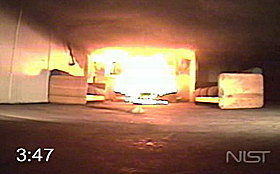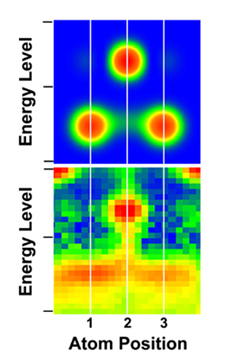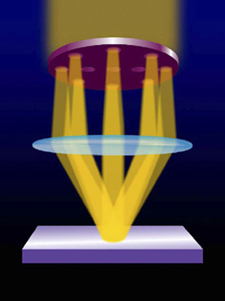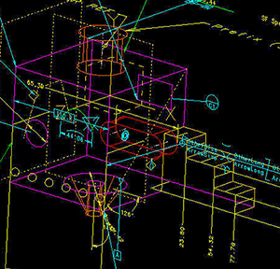Feb. 10, 2005

[NIST
Tech Beat Search] [Credits] [NIST Tech Beat
Archives] [Media
Contacts] [Subscription Information]

President
Proposes Funding for NIST FY 2006 Programs
An
increased emphasis on research to support key Administration
priorities in advanced manufacturing, homeland security, and
health and information technologies highlights the FY 2006 request
for the National Institute of Standards and Technology (NIST)
submitted to the Congress on Feb. 7 by President Bush. The budget
proposes a total of $532 million in NIST funding.
The NIST budget is divided into three appropriations:
-
$426.3 million for Scientific and Technical Research and Services
(STRS)—an increase of 12.5 percent over 2005. It includes
$420.6 million for the NIST laboratories, technical programs
and major user facilities that provide U.S. industry and the
science/technology community with the measurement capabilities,
standards, evaluated reference data and test methods needed
to support innovation and improve quality in virtually all
technology-intensive sectors; and $5.7 million for the Baldrige
National Quality Program.
-
$46.8 million for Industrial Technology Services (ITS), funding
the Hollings Manufacturing Extension Partnership Program,
helping small manufacturers across the nation to become more
competitive and productive. Consistent with efforts to shift
resources to best meet national needs, the FY 2006 budget
proposes termination of the Advanced Technology Program.
-
$58.9 million for Construction of Research Facilities (CRF),
covering critical safety, maintenance, repair and facilities
upgrades.
The proposed
budget request includes three STRS initiatives that target pressing
national research priorities in Advanced Manufacturing ($19.6
million), Measurements and Standards for Homeland Security ($3
million), and New Measurement Horizons for the U.S. Economy
and Science ($17.2 million).
The CRF
budget request includes an increase of $32 million to address
pressing issues of facility modernization primarily at the NIST's
Boulder, Colo., laboratories and an increase of $3.4 million
to support necessary preventive maintenance for NIST’s
Advanced Measurement Laboratory, one of the world’s most
sophisticated laboratories and a valuable national resource
for critical measurements in nanotechnology, biotechnology,
quantum computing and other exacting fields.
For further
information, see http://www.nist.gov/public_affairs/releases/budget_2006.htm.

Sprinklers
Shown Effective in Slowing Dorm Fires
 |
| Photo
of a NIST experiment in a dorm day room without sprinklers
3 minutes and 47 seconds after a fire was ignited. |
A
n automatic sprinkler system significantly increases a person’s
chances of surviving a dormitory fire, according to a report
issued recently by the National Institute of Standards and
Technology (NIST).
Three
NIST experiments,* supported by a U.S. Fire Administration
(USFA) initiative for fire safety in college housing, compared
the hazards of fires in smoke detector-equipped dormitories
with and without fire sprinklers in the room of fire origin.
Researchers started fires in a day room or lounge area open
to the corridor of a dormitory. They used the temperature
of 120 degrees C (248 degrees F) as the cutoff mark for
human survival. For comparison, the temperature of boiling
water is 100 degrees C.
In
two experiments without sprinklers, potentially fatal temperatures
exceeding 120 degrees C as well as toxic gases reached a
remote corridor 22.9 meters (75 feet) away within three
minutes and completely spread throughout the corridor within
another three minutes. In an experiment with sprinklers,
temperatures at the 1.5 meter (five feet) level and below
in the room where the fire began never exceeded 120 degrees
C. No significant increase in heat was measured in the corridor
during the experiment, allowing adequate time for residents
to escape.
NIST
conducted the experiments at a barracks donated by the Myrtle
Beach Air Force Base Redevelopment Authority in Myrtle Beach,
S.C. The USFA incorporated footage of NIST sprinkler tests
into a fire safety video for college administrators and
students.
*The
NIST report Impact of Sprinklers on the Fire Hazard
in Dormitories: Day Room Fire Experiments (NISTIR
7120) by D. Madrzykowski, D. Stroup and W.D. Walton
is available,
with video showing the experiments in progress in DVD format.
Send requests to david.stroup@nist.gov.


Experiments
Prove Existence of Atomic Chain 'Anchors'
 |
Image credit: J. Crain,
D. Pierce/NIST
The
two images above show the energy levels (vertical scale)
and spatial positions (white lines) of electrons within
a three-atom chain. The top image shows the calculated
or theoretical results; the bottom image shows the measured
energy levels in a physical experiment. Electrons are
most likely to be located in the red areas and least
likely in the blue areas. Both images indicate that
the electrons in the outermost atoms (positioned on
the far left and right at the bottom on the vertical
scales) have lower energy than those within the center
atom.
Click
here to download a higher resolution version of this
image.
|
A
toms at the ends of self-assembled atomic chains act like
anchors with lower energy levels than the “links”
in the chain, according to new measurements by physicists
at the National Institute of Standards and Technology (NIST).
The first-ever
proof of the formation of “end states” in atomic
chains may help scientists design nanostructures, such as
electrical wires made “from the atoms up,” with
desired electrical properties.
The NIST
experiments, described in the Feb. 4 issue of the journal
Science,* involved measuring and comparing the electronic
properties of gold atoms in short chains assembled on silicon
surfaces. Energy levels of the electrons within the end atoms
of the chains were lower than those of inner atoms. This condition
arises because the structural, chemical and electronic symmetry
of a chain is broken at each end, and the atoms’ electrons
are redistributed to lower the chain’s energy. The electronic
structure of atomic chains is comparable to the electronic
structure of bulk crystals, in which surface atoms have different
properties than atoms inside the crystal.
“In
the past three decades the study of surface states on crystals
has been a major endeavor by research groups from all over
the world,” says Jason Crain, lead author of the Science
paper. “Our study is the first to show the formation
of localized states at the ends of single atom chains. The
existence of end states will have implications for future
studies of one-dimensional nanostructures.”
The NIST
measurements were made with a scanning tunneling microscope
(STM) and were enabled, in part, by the self-assembly of the
gold chains on a silicon surface. Unlike the metal surfaces
used in previous STM studies of single-atom chains, the silicon
surface behaved as an insulator, allowing scientists to better
isolate the chains and improve measurements of their atoms’
electron energy.
For
further information, see http://www.nist.gov/public_affairs/releases/atomic_anchors.htm.
Devising
Nano Vision for an Optical Microscope
 |
Image credit: Beamie Young/NIST
A new optical imaging technology under
development at NIST will use combinations of dynamically
controlled light waves, optimized for particular properties
(such as polarization). How this structured illumination
field -- engineered specifically to highlight the particular
geometry of each type of specimen -- scatters after striking
the target may reveal features smaller than 10 nanometers.
|
Contrary
to conventional wisdom, technology’s advance into the
vanishingly small realm of molecules and atoms may not be
out of sight for the venerable optical microscope, after all.
In fact, research at the National Institute of Standards and
Technology (NIST) suggests that a hybrid version of the optical
microscope might be able to image and measure features smaller
than 10 nanometers—a tiny fraction of the wavelength
of visible light.
In
a preliminary test of the embryonic technique, NIST scientists
used violet light with a wavelength of 436 nanometers to image
features as small as 40 nanometers, about five times smaller
than possible with a conventional optical microscope.
Roughly
speaking, such a feat is akin to picking up a solitary dime
with a clumsy front-end loader. If successfully developed,
the imaging technology could be readily incorporated into
chip-making and other commercial-scale processes for making
parts and products with nanometer-scale dimensions.
The wavelengths
of light in the visible part of the spectrum greatly exceed
nanoscale dimensions. Consequently, the resolution of conventional
light-based imaging methods is limited to about 200 nanometers—too
large to resolve the details of nanotechnology, which, by
definition, are no more than half that size.
 |
Image credit: Beamie Young/NIST
Resembling
a 3-D checkerboard, this mirage-like pattern was
formed by light waves after bouncing
off a specimen with a peak-and-valley arrangement
of etched lines. Such complicated wave patterns,
the
result of light
scattering and interference effects, may be used
to discern the dimensions of nanoscale features.
|
However,
a newly begun, five-year research effort at NIST suggests
that a novel combination of illumination, detection and computing
technologies can circumvent this limitation. Success would
extend the technology’s 400-year-long record as an indispensable
imaging and measurement tool well into the expanding realm
of nanotechnology.
Called
phase-sensitive, scatter-field optical imaging, the computer-intensive
technique under development at NIST uses a set of dynamically
engineered light waves optimized for particular properties
(such as angular orientation and polarization). How this structured
illumination field—engineered differently to highlight
the particular geometry of each type of specimen—scatters
after striking the target can reveal the tiniest of details.
“The
scattering patterns are extremely sensitive to small changes
in the shape and size of the scattering feature,” explains
Rick Silver, a physicist in NIST’s Precision Engineering
Division.
Media
Contact:
Mark
Bello, mark.bello@nist.gov,
(301) 975-3776


Helping
Future Engineers Use Today's Design Plans
 |
| Detail
of a STEP product assembly diagram. |
Digital
design software has virtually replaced blueprints across all
manufacturing sectors. STEP (the Standard for the Exchange of
Product Data), a universal format for product data that allows
industrial partners with different proprietary software to understand
and share engineering data, has accelerated this change. The
National Institute of Standards and Technology (NIST) and PDES,
Inc., an industry consortium, have just introduced a new STEP
standard that should help ensure that tomorrow's engineers will
be able to understand today's complex designs.
The new
standard allows more sophisticated descriptions of proprietary
designs and processes. This should eliminate the need for manufacturers
to understand and consult a wide variety of original software
programs. The additional descriptive information covering three-dimensional
mechanical designs and assemblies also should help engineers
to duplicate or repair complex machines such as aircraft, or
ships, long after the original design and manufacturing software
has been discontinued or changed beyond recognition.
The new
STEP standard, called AP203 Edition 2, supports the latest advances
in product design. It can be used to express complex three-dimensional
mechanical part models and assemblies with features, tolerances,
and colors, which may denote, for example, specific types of
systems, such as hydraulic and electrical, or other details
especially important in manufacturing.
The International
Organization for Standardization (ISO) is expected to publish
the new STEP protocol this month for distribution and implementation
by software vendors and manufacturers. NIST developed AP203
Edition 2 with private-sector partners, including aerospace,
automobile, shipbuilding and computer software corporations.
Media
Contact:
John
Blair, john.blair@nist.gov,
(301) 975-4261


New
Judges Appointed to Baldrige Award Panel
Four
prominent industry and education leaders have been appointed
to serve on the nine-member panel of judges for the Malcolm
Baldrige National Quality Award to replace retiring panel
members. The leaders were appointed by Donald Evans, now
the former U.S. Secretary of Commerce.
The
new members are: Lloyd Barker, director, corporate quality,
Alcoa Inc., New York, N.Y.; David C. Branch, chairman
and chief executive officer, Branch-Smith Resources, Ltd.,
Fort Worth, Texas; James R. Evans, professor of quantitative
analysis and operations management and director, Total
Quality Management Center, College of Business, University
of Cincinnati, Cincinnati, Ohio; and Steven C. Lampa,
senior vice president of lodging quality assurance &
rooms operations, Marriott International Corp., Washington,
D.C.
The
panel of judges is part of the award’s mostly private-sector
board of about 500 examiners who review applications for
the Baldrige Award. The Baldrige Award is the nation’s
highest Presidential award for quality and organizational
performance excellence. The judges review examiner comments
and scores, select applicants for site visits and recommend
Baldrige Award recipients to the Secretary of Commerce.
Other
judges are: Roy A. Bauer (Chair), Pemstar Inc., Rochester,
Minn.; Jane R. Brown, Second Harvest Heartland, St.
Paul, Minn.; Steven D. Hagedorn, Mayo Clinic Rochester,
Rochester,
Minn.; Deborah Lee-Eddie, Catholic Health Initiatives,
Denver, Colo.; Deborah L. Myers, Hamilton County Educational
Service Center, Cincinnati, Ohio; Joseph Sober, Dana
Integration
Technology, Toledo, Ohio; and Maureen M. Travalini, Kaiser
Permanente CSC, Fort Worth, Texas.
Media
Contact:
Jan
Kosko, janice.kosko@nist.gov,
(301) 975-2767


Quick
Links
Baldrige
Winners Share Best Practices
Learn
about the exceptional practices and results of the
2004 winners of the Malcolm Baldrige National Quality
Award at the Quest for Excellence XVII, April 10-13,
2005, in Washington, D.C. The 2004 winners are: The
Bama Companies, Texas Nameplate Company, Inc., Kenneth
W. Monfort College of Business, and Robert Wood Johnson
University Hospital Hamilton. The Baldrige Award recognizes
organizations in manufacturing, small business, service,
education, and health care for their performance excellence
and quality achievements.
Throughout
the three-day conference, senior leaders and others
from each of the 2004 Baldrige Award recipients will
give presentations and answer questions in areas including
process management, performance results, effective
leadership, and customer and employee satisfaction.
Two pre-conference workshops will help attendees better
understand how to use the Baldrige criteria for performance
excellence as a tool to assess and improve their organization.
For
more information, see http://baldrige.nist.gov/Quest_for_Excellence.htm
or call (301) 975-2036.


PBS
Features NIST/NARA Charters of Freedom Work
The
recently completed effort to preserve and protect the nation’s
founding documents—the Declaration of Independence,
Constitution and Bill of Rights—will be featured in
a television documentary by Public Broadcasting System’s
NOVA program on Tuesday, Feb. 15 at 8 p.m. EST. The program
will offer a behind-the-scenes look at the work of National
Institute of Standards and Technology (NIST) engineers,
National Archives and Records Administration (NARA) specialists
and others who participated in the preservation project.
Titled
“Saving the National Treasures,” the program
will follow the entire project from the design of the state-of-art
encasements for the documents to the building of a new Rotunda
for their viewing. NIST’s contribution to the NARA-directed
preservation effort, included designing and building nine
hermetically sealed glass, titanium-framed cases capable
of protecting the documents against all types of environmental
assault. NIST partners in the project included the National
Aeronautical and Space Administration (NASA) and Heery International,
Atlanta, Ga.
For
local listings, see http://www.pbs.org/wgbh/nova/schedule-local.html.
The
NOVA Web site offers a comprehensive look at the entire
project, including teacher’s guides at http://www.pbs.org/wgbh/nova/charters/.
NIST's
Web site describes the encasement project, NIST’s
1950's Charters preservation work and the Charters
themselves
at http://www.nist.gov/public_affairs/Charter/charters_of_freedom_project.htm.


Cryptography
Program Issues 500th Certificate
A
program
established in 1995 to help federal agencies protect sensitive
information recently reached a milestone when the 500th
cryptographic module was validated as conforming to a standard
set of security requirements (Security Requirements
for Cryptographic Modules, FIPS PUB 140-2). Cryptographic
modules can be hardware and/or software that implement cryptographic
logic or processes such as an encryption algorithm. NIST,
in conjunction with the Canadian government’s Communications
Security Establishment, developed the Cryptographic Module
Validation Program to help federal agencies in both countries
procure equipment known to conform to the federal security
standard.
Federal
agencies in the United States are required to use cryptographic
modules that have been validated by this program. Nine laboratories
in the United States, Canada and the United Kingdom are
accredited by NIST to test cryptographic modules. The 500th
certificate was issued in January to Research in Motion,
Ontario, Canada.
For
more information on the CMVP, including a list of validated
modules and accredited testing laboratories, see http://csrc.nist.gov/cryptval.


(Return
to NIST News Page)
Editor:
Gail Porter
Date
created:2/8/05
Date updated:2/10/05
Contact: inquiries@nist.gov
|

